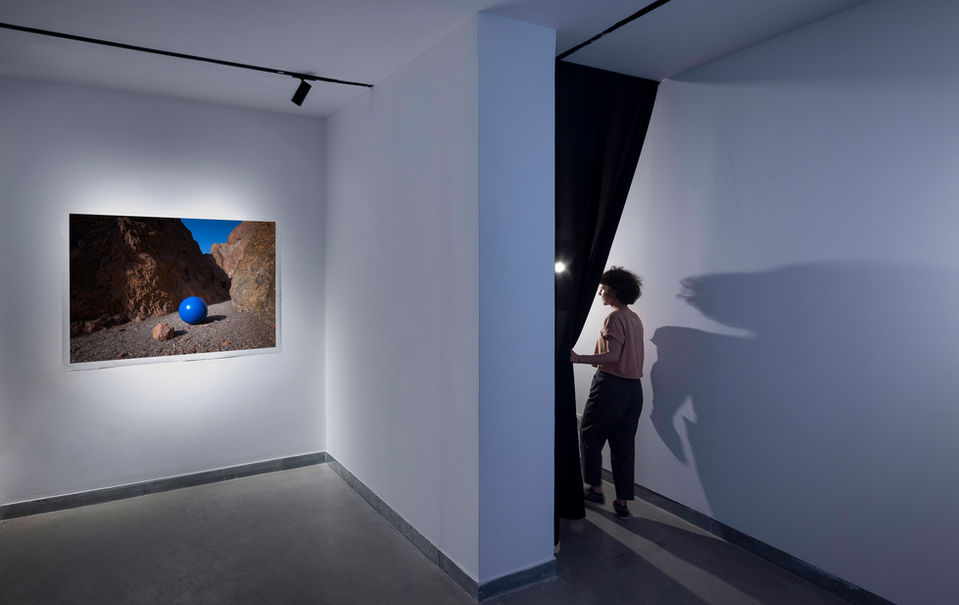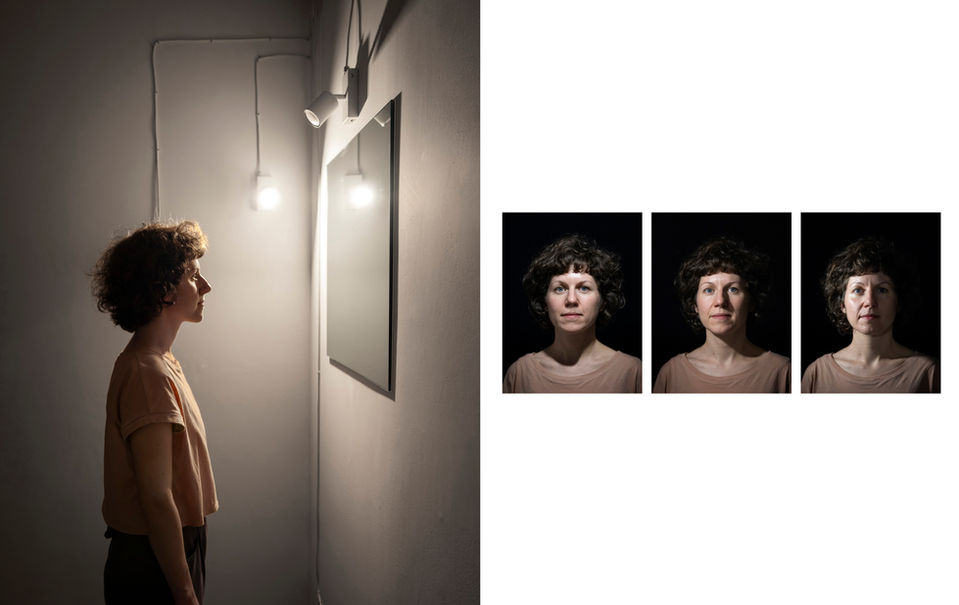
Solo Show, Art Cube Artists' Studios, Jerusalem
Curator: Yair Barak. June- September 2023
Installation view of the exhibition Invisible Ocean, Art Cube Artists' Studios, Jerusalem.
Curated by Yair Barak. June- September 2023. photography: Dafna Tal
A Voice Echoing Itself
Yair Barak
In recent years, Dafna Tal has been working with photography and video, placing universal human issues at the heart of her artistic practice. Oscillating between personal identity and collective identity, her work explores the relationship between time, body, and place. Tal’s current exhibition space consists of several active focal points. At first glance, they seem to have little in common: a dark booth with a mirror and a lighting system, stills photos of an object placed in the middle of a landscape view, three sculptural projections on basic geometric shapes, and an audiovisual work that features human figures in a dark space. I would like to start with the latter, which I consider as the generating nucleus of the entire constellation of works. The flow that runs through each of the other pieces originates in these pulses.
The video work You're Gorgeous, You're Mad, created during her stay at an artist residency in Virginia, USA, is in fact a documentation of an action that has therapeutic characteristics. In the first part of the project, the participants were invited to take part in a series of audio confessions that expose how they perceive themselves and how they are perceived by those around them. This profound process was carried out in two stages: in the first, the participants focused on their strengths, and in the second – on their weaknesses and the character traits they tend to conceal. The artist recorded the interviews and then edited the recordings into two short audio clips.
A couple of days later, Tal invited the participants to her studio, which I wish to liken to a confessional booth. The participates stayed in a dark room and listened to their recorded interviews: first, to the series of statements describing their strengths, and then to the statements about their shortcomings. Essentially, they faced their own voice and statements, but this time these were directed at them from the outside, as if they became an external voice, detached from their body. While listening to the audio of their statements, they also examined their image reflected in a two-way mirror. For them, this was their familiar likeness, and for Tal, who stood on the other side of the mirror and filmed their reactions – this was a window through which she could witness their physical reactions: their body language and facial expressions.
In the classical myth of Narcissus, he comes across his reflection in the water, and his gaze into himself soon becomes an infatuation. The myth of Narcissus is a formative image in Western culture that fed psychological theories and was even defined as a personality disorder. Tal’s subjects do not fall in love with their own reflection. They examine it, study it, unite it with their voice and their complex consciousness. Filmed in Tal’s trademark meticulous and highly aesthetic style, the video quickly becomes a stage – and the participants – the figures who stand on it and emerge from the darkness.
As mentioned, the physical and mental situation that Tal conjures in this work is evocative of the confessional act, and leads us to another work in the exhibition. The Invisible Whole is a sculptural object, between a changing booth and an isolation room, inviting a single viewer to spend time in the company of his own reflection, his body and face illuminated dramatically. The lighting is dynamic, altering the appearance of the subject’s reflections in the mirror. Tal offers visitors an opportunity for an intimate encounter with their body, but even more so with their gaze. In the narrow and confined space, there is nowhere to escape.
Space and Sphere are direct photographs, taken on two occasions that are far removed from one another in time and place. The first was taken on the US East Coast in 2018, and the second in the Eilat Mountains in 2023. In both cases, the photo captures a transient sculptural intervention in the landscape, like the type of actions that characterized the 1970s and 1980s American Land Art pioneers. The white cube is a quintessential Modernist shape, like a platform or an unrealized pedestal: It is the possibility to uphold a person or an exhibit, a potential object of gaze. The white structure punctures the horizon line and interrupts the simple sea-sky relationship. The blue ball (almost Yves Klein Blue) meets rough, desert, brown terrain. This is an encounter of resistance, but miraculously, also one of completeness. Like the encounter between a desert shore with a blue sea. Perspective is a video installation comprised of three geometric objects: circle, triangle, and square. The three basic shapes become three receptacles that attempt to define and demarcate what cannot be demarcated. The flickering images of water projected on them summon a metaphysical experience of a transcendental dive into the depths of the sea.
The subtle video work Overflow almost functions as a footnote in the body the exhibition. Tal directed a camera at an expansive desertscape and swayed it in a pendulum-like motion. Her video work produces intensive movement in the desert landscape, destabilizing the horizon and bringing to mind the movement of a ship riding the waves. This conceptual reversal expresses a duality that has become typical of Tal’s work in recent years – and in this exhibition as well. The ambivalent and vacillating self image of the participants in the central video work, the paradoxical inversion of the water sculptures (there is nothing more amorphous than water, there is nothing more defined than a polygonal shape) and the color and material clash in the still photographs – all these activate the same dual and complex perspective synonymous with Tal’s artistic thinking.






